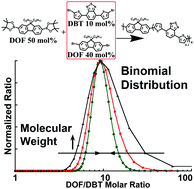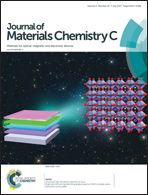Effects of a random copolymer's component distribution on its opto-electronic properties†
Abstract
The effects of the component distribution of a red light-emitting random copolymer poly(9,9-dioctylfluorene-co-(4,7-dithienyl-benzothiadiazole)) (DOF : DBT = 9 : 1 mol/mol, PFO-DBT10) on its optoelectronic properties are systematically investigated. The PFO-DBT10 copolymers with various molecular weights (MWs) have identical absorption spectra and energy levels. However, as the molecular weight increases, so does the photoluminescence intensity ratio of DBT to DOF segments. For polymer light-emitting diodes, PFO-DBT10 with a large MW shows an enhanced charge trapping effect, leading to increased operation voltage under any given current density, worse luminous efficiency, and more saturated red emission, compared to the one with a small MW. The experiments are performed within the framework of the component's molar ratio dispersion of random copolymer chains induced by the MW using the binomial distribution formula. According to the formula, the high MW random copolymer is analogous to the ideal PFO-DBT10 in terms of the uniformly distributed units. The low MW random copolymer is more likely to be a mixture of pure PFO and PFO-DBTx, in which the molar ratio x varies, due to its dispersive component distribution. This work offers a new approach to study the opto-electronic properties of random copolymers in the light of component distribution.



 Please wait while we load your content...
Please wait while we load your content...